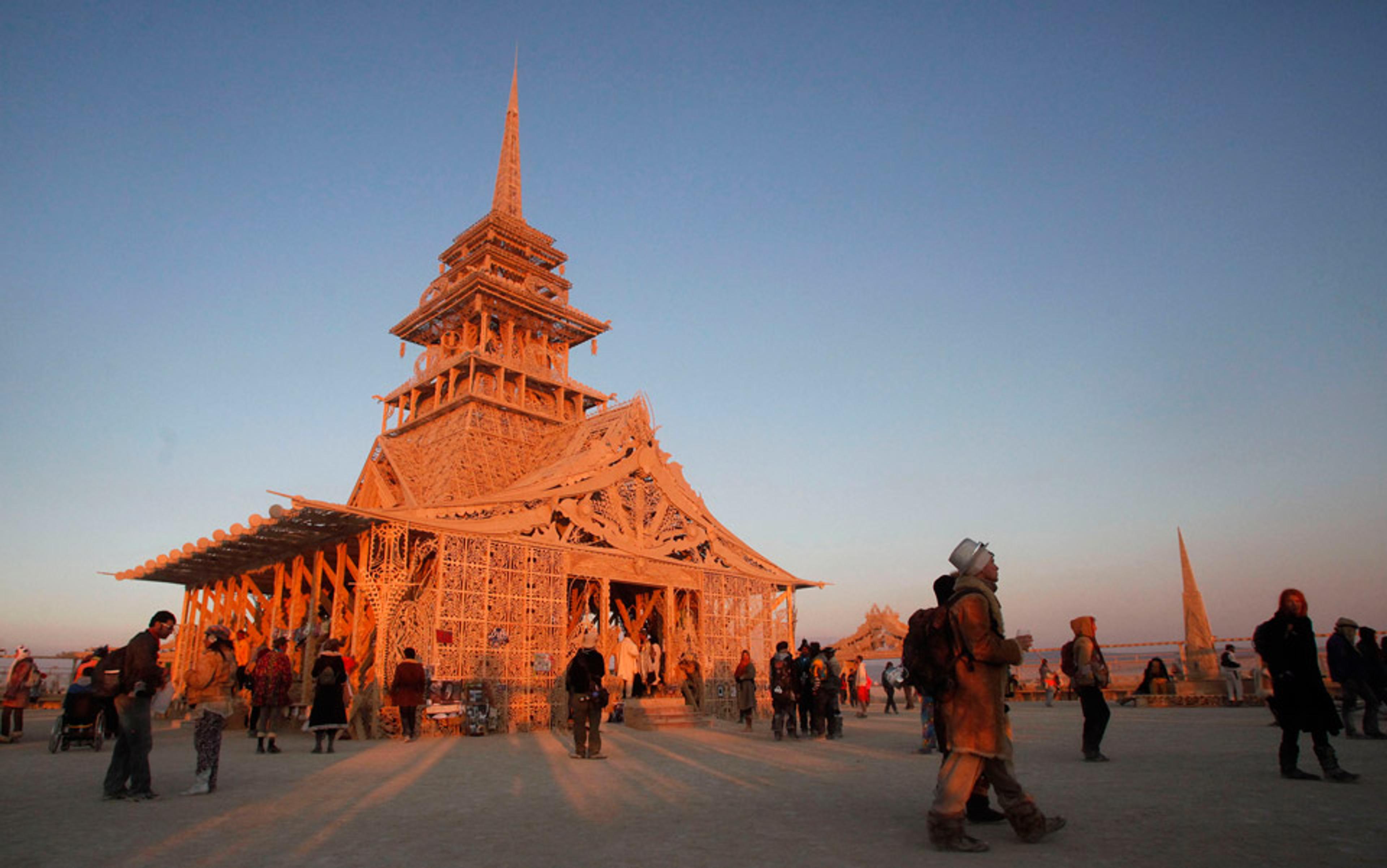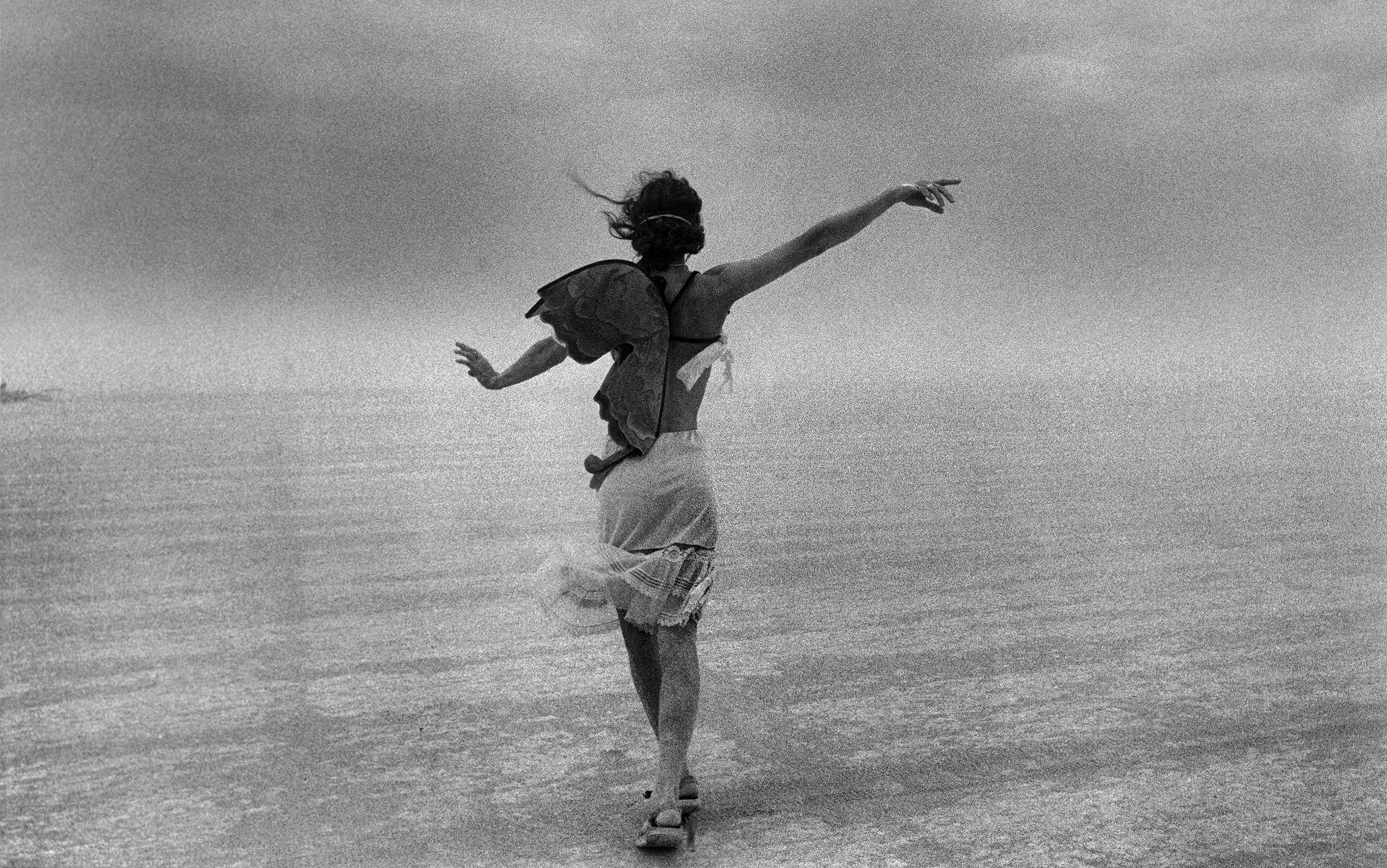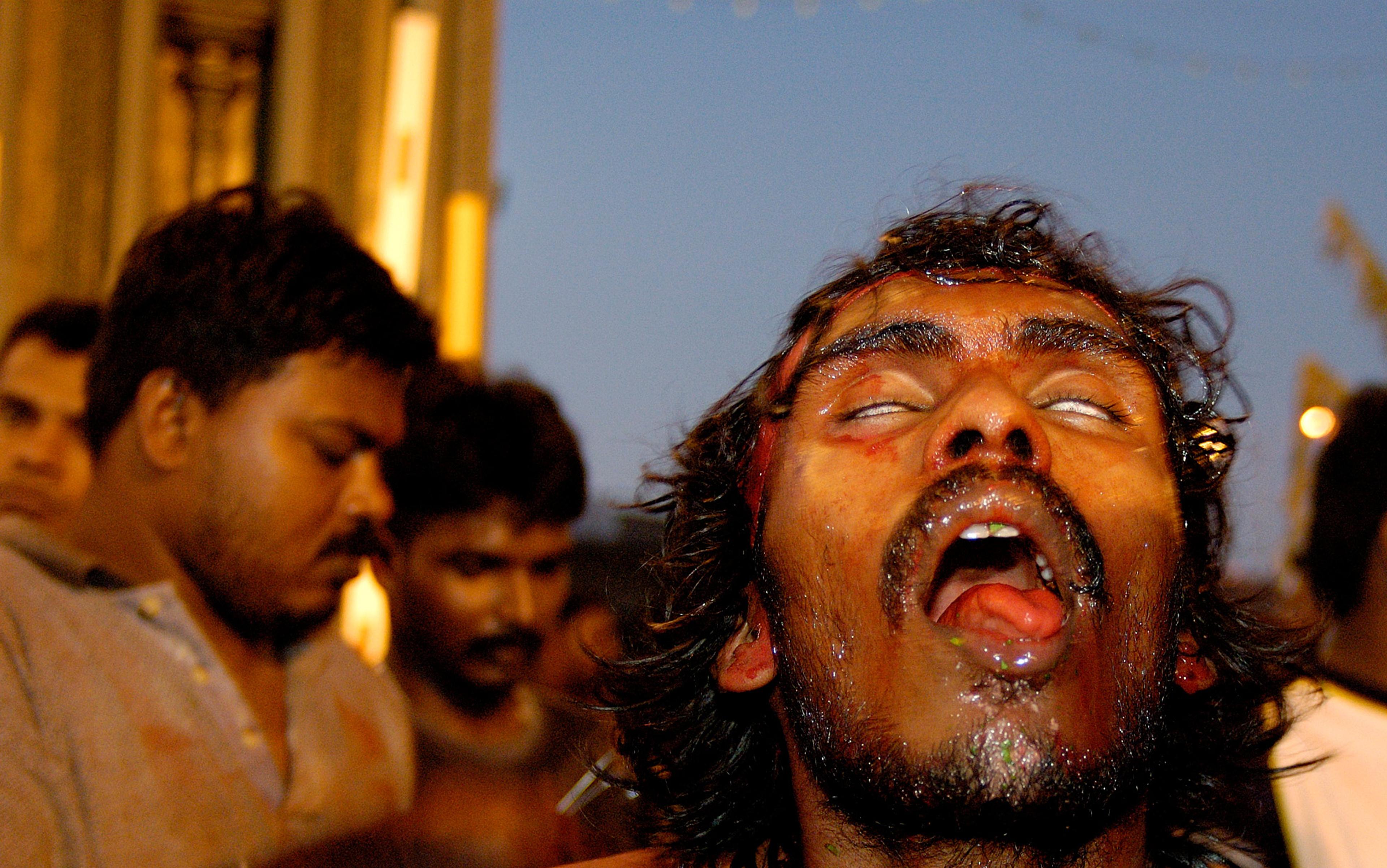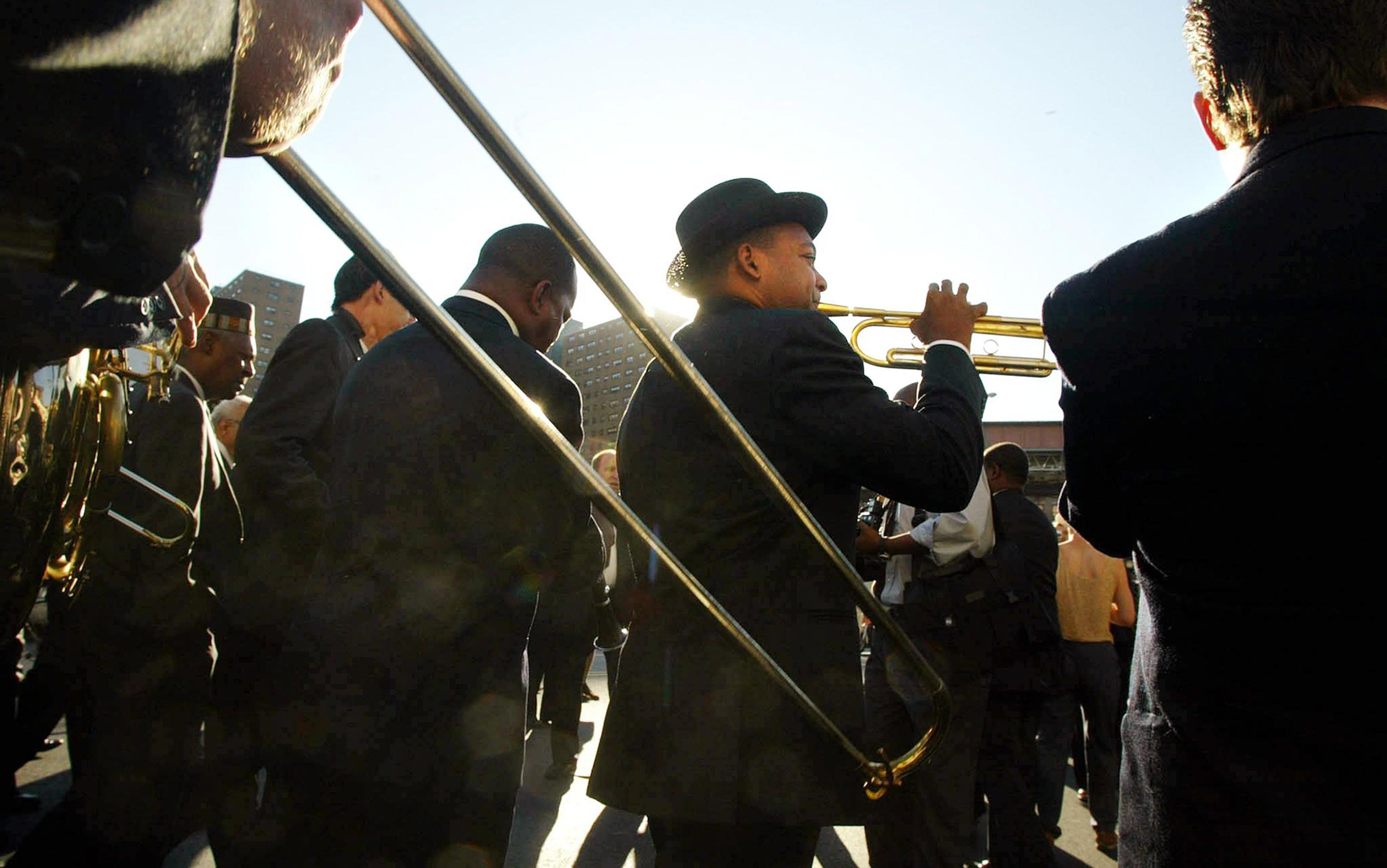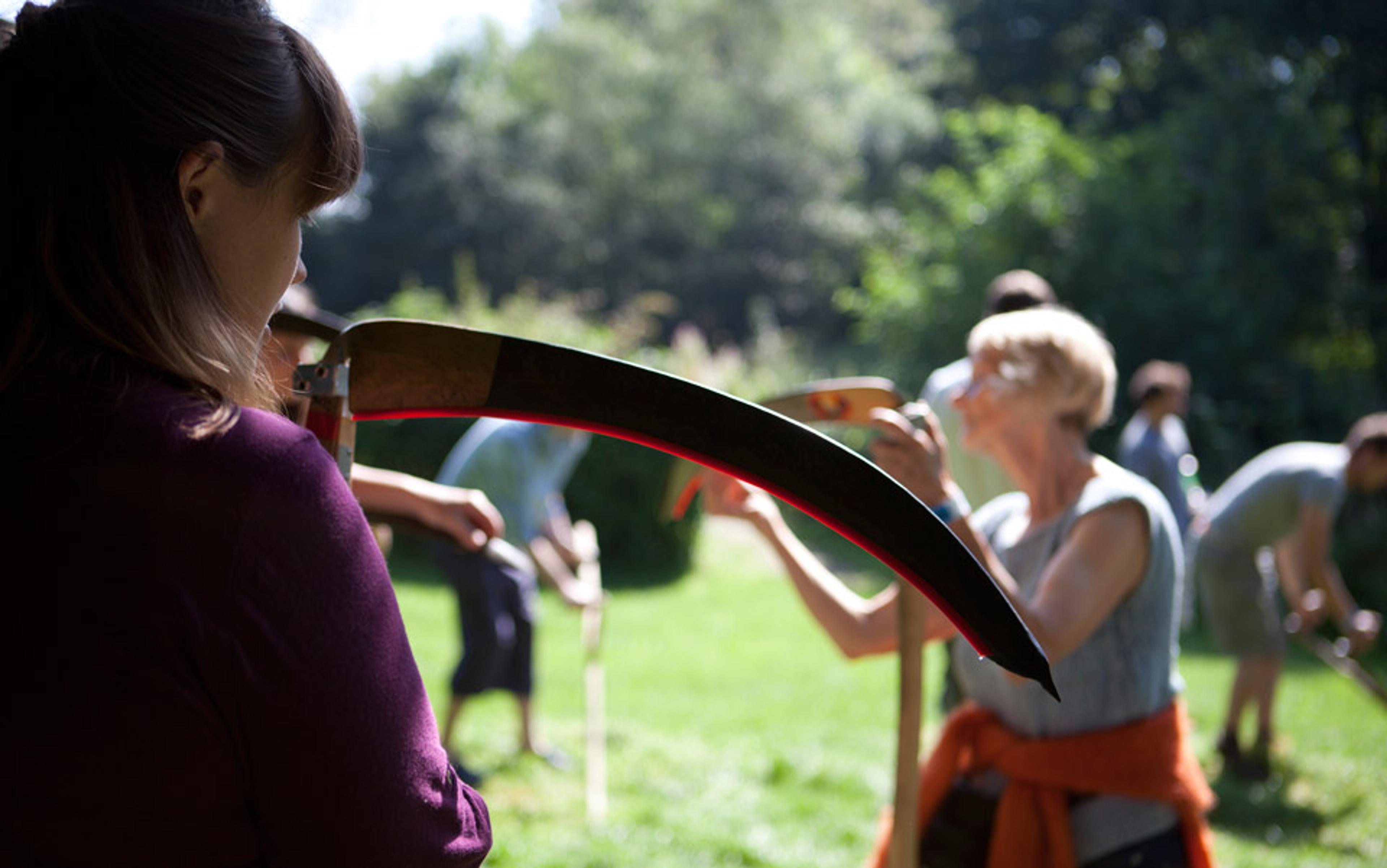Just after sunrise, I cycled towards the Temple of Juno, a pagoda-like structure obscured in the distance by the desert haze of dust. It was a long ride from my camp at the corner of Lilac and 3:30 streets in Black Rock City. I rode by a steel dragon the size of a school bus which blasted electronica as dancers swayed to the beat and looked towards the sun rising over the Nevada desert. Part-Viking vessel, part-steampunk museum piece, the dragon was a dance club roaming the streets of the Burning Man festival. Its motorised companions — among them, a giant, roving octopus; vans made into insects; a shiny aluminum duck; a space shuttle — were ‘mutant vehicles’. These cars, vans, bicycles, and buses transformed into moving sculptures are the only ones allowed by the event organisers to drive on the ‘playa’, a prehistoric lakebed full of nothing but alkaline dust and art pieces.
In the early hours before the its coming demise, the temple was quiet, except for some Hare Krishnas chanting in one corner of the courtyard and a guitarist playing through a small amplifier in the other. Inside, a woman dressed up in red lace meditated in the lotus position in front of the central altar while the man next to her, coated entirely in silver paint, took photos of the altar and its offerings. Some ‘Burners’ (as the festivalgoers are called) wore furs against the morning chill. Others were sunburned and naked, oblivious to the dust and the cold. They were busy writing or reading messages, praying softly to themselves, weeping.
The air was thick with grief and loss. Every surface of the walls, arches, stairs, and altars was covered with messages, letters, photos, and offerings. The face of a beloved German Shepherd, its collar hanging from a picture frame; the smile of a grandmother in a yellowed photo; the military uniform of a father — they all sat side by side on an altar, strangers until now.
Some messages spoke of the living: ‘May the cancer in the cells of all who are living with that disease melt away by the graceful fire of this temple and the true and clear prayers of us all that we offer this evening.’ But most were dedicated to the beloved dead: ‘This burn was for my brother Bill who died in June of this year… he was in the temple now I can put his ashes away.’ And ‘For my beloved — in the light you still guide me … the universe can feel just how much I miss you.’ And: ‘For my little sis… died age five… never had a chance.’ No boundaries or borders distinguished one person’s grief from another’s. Mourning was contagious, afflicting us all as we gazed on thousands of photos of dead sons, mothers, lovers and pets, a three-dimensional collage of collective loss.
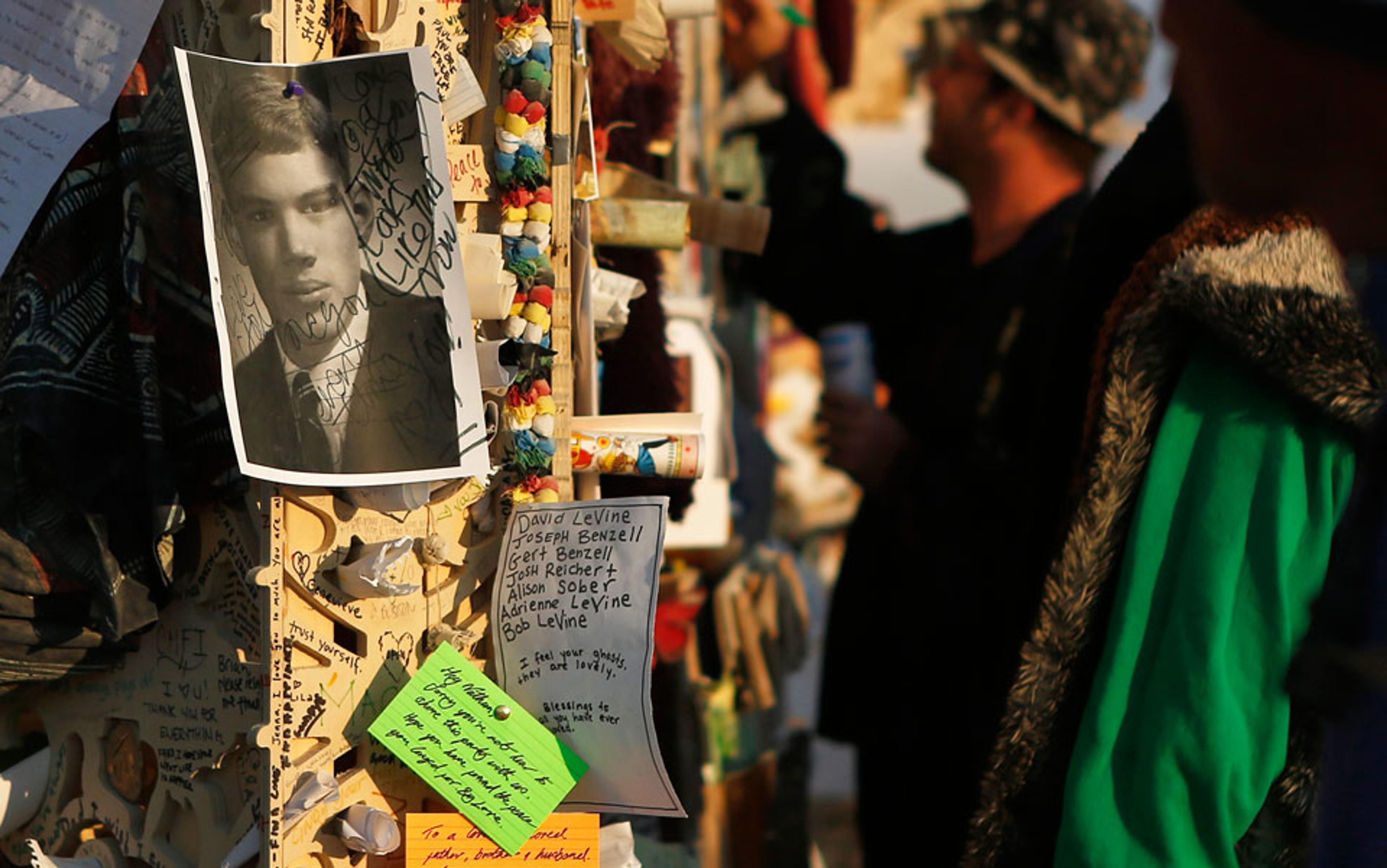
An atmosphere thick with grief: mementos of the dead adorn the Temple of Juno
The Temple is built in the Black Rock Desert of Nevada at the end of every summer, as part of the Burning Man festival. The festival itself attracts artists, computer programmers, dance music DJs, Buddhists, rabbis, fire dancers, carpenters, massage therapists and others of all ages and from all kinds of backgrounds. Started in 1986 by the artist Larry Harvey, who burned an effigy on a beach in San Francisco which drew a small crowd, the festival is now bursting at the seams, with more than 50,000 attendees from around the world. The organisers want to increase attendance to 75,000, if they can get permission from the Bureau of Land Management, a government agency that manages the desert. Burning Man has also spawned regional ‘Burns’ from Australia to New Jersey, as well as ‘Decompressions’ and ‘Afterburn’ parties.
Anyone who can pony up several hundred dollars for a ticket, and get together all the food and water needed for a week in the desert can attend. The semi-circular encampment of Black Rock City runs on a gift economy: nothing is for sale within festival boundaries, except ice and coffee drinks sold by the Burning Man organisation. Wandering its temporary streets, I was offered pancakes and a cup of tea, flashy costumes and a manicure, as Burners tried to outdo each other in their generosity. No one goes wanting in this gifting city full of food and fashion.
Each year, the place comes alive as festivalgoers arrive with camping gear, pavilions, art installations, costumes, masks, body paint, and a range of temporary desert homes. Musical and theatrical performances, tea parties, dance marathons, meditation tents, yoga sessions, and many other events are scheduled all day and night. But most Burners spend their time wandering. They visit old and new friends, take part in croquet and poker games at neighbors’ camps, frequent hundreds of themed bars, and look at lots of art. Every year, Black Rock City is created anew and then totally dismantled when the week is over. At the end of the festival, Burners shed their feathers and glitter and go back to work in what they like to call ‘the default world’. But volunteer crews remain for weeks until they can leave the desert just as it was when they arrived.
As a sacred destination, Burning Man is rife with contradictions, some of them disturbing
Events such as Burning Man are flourishing in the US, especially among young adults. According to Burning Man’s census, close to half of attendees are under 30 years old. Polls show that the number of Americans of all ages exploring spirituality outside institutional religion is on the rise too. Jeet-Kei Leung, musician and organiser of the Mystic Garden festival, proclaims such events as the spiritual wave of the future. In a TED talk in 2010, he praised ‘transformational festivals’ for rejoining ‘sacred ritual with secular festival’. Festivals such as Burning Man offer participants opportunities for pilgrimage, transformation and spiritual experience without requiring any commitment to a specific creed. For many Burners, this is their church or religious holiday: a sacred time and place set apart from ‘the default world’. Like other festivals, it offers an escape from the society they leave outside its gates. As the naked greeters say to those arriving at the festival: ‘Welcome home’. Burning Man is a sacred space that embraces opposites, a place of inversion and dissent, of intense seriousness and lighthearted play.
After travelling many hours along a two-lane highway across a barren desert landscape, Burners feel like pilgrims shedding their old ways, open to new possibilities. But as a sacred destination, Burning Man is rife with contradictions, some of them disturbing. Heavy drug use and drinking coexist with ascetic New Age regimes. A camp down one street is hosted by an evangelical preacher urging passers-by to get saved while, down another, Bianca’s Smut Shack offers pornography. A Buddhist meditation retreat is next door to a rollerskating rink. Trampolines and children’s swimming pools beckon Burners of all ages throughout the city. And the slogan ‘Leave No Trace’ is belied by the trash bags littering the highway leading out from the Burning Man site. This place, which is supposed to be liberated from all ordinariness, nonetheless requires the presence of hundreds of police, fire fighters, emergency medics and drug enforcement officers.
The Man itself and the Temple of grief together embody the dual nature of the festival experience. The Man, an abstract sculpture that looms over the festival space, is a universally recognised symbol of the event. This genderless figure is traced in dust on cars when Burners travel home, painted and tattooed on their bodies, stencilled on banners to decorate camps, and crafted into necklaces to give away to other Burners. It marks the centre of Black Rock City from which everything else emanates. Every year the figure looks the same, but different artists design its base. This year’s arched base was colorfully lit by night, but by day its walls were simple and functional. On them, Burners wrote lighthearted graffiti: ‘Make tea, not war’, ‘You are beautiful, welcome home’, ‘Peace, love, light’. There were no offerings or altars. Burners wandered through, watched each other, chatted with friends, shared cans of beer, and gazed out at the city spread before them. Every year, in an extravaganza of fireworks, rave music, art cars, costumed stilt-walkers, fire-spinning, and wild parties, the Man is burned down on the Saturday of the festival, and revelers cheer and dance around its ashes all night long.
By contrast, down a lantern-lined avenue away from the Man and the city stands the temple. Within the ritualistic space of the whole festival, Burners create the same kind of opposition that exists between Burning Man and the outside society. If the Man is exuberance and excess, the temple offers an experience that is deeper and more intimate. Both are sites of collective rituals, but one is for festivity and play, while the other speaks to sorrow and loss. Each allows for the expression of feelings that are repressed in the outside world. Yet it is the Temple that has become the heart and soul of Burning Man, stealing that honour from the festival’s namesake. The temple too is burned to the ground, but in an altogether different atmosphere.
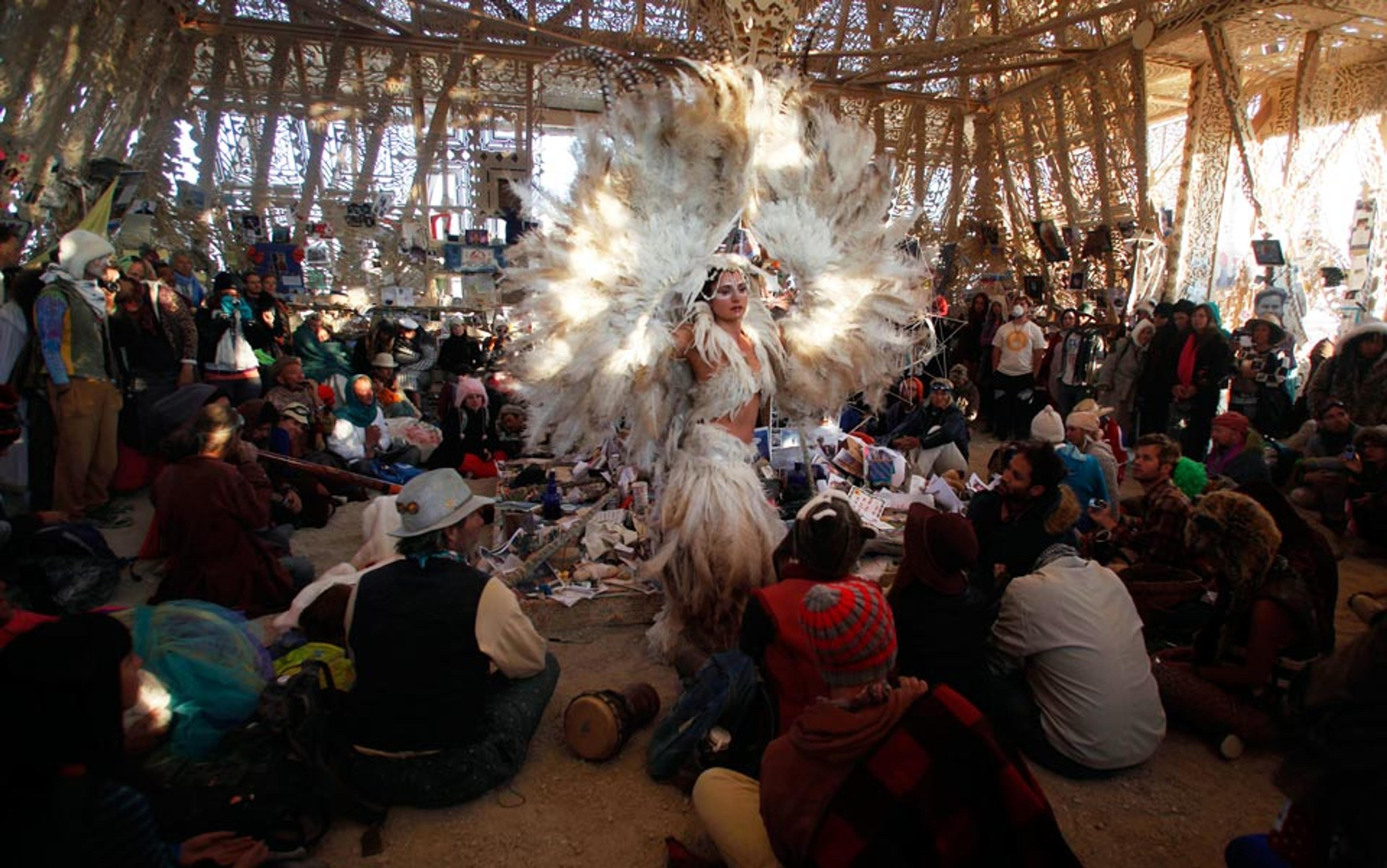
A dawn gathering at the Temple of Juno on the last day of its ephemeral existence.
What makes the Temple feel sacred, a space to approach with reverence, while the Man is not treated in quite the same way, despite being new every year? Burners might know what they will find at the temple, but what makes it so very powerful are the images of the dead and the intentions of the living invested in the messages and offerings at the altar. The temple speaks to a society looking for new ways to mourn its dead.
I have been coming to Burning Man since 1997. This year, I arrived before the event officially opened and watched the temple being finished by the artist David Best and his ‘Temple Crew’. Each year, a temple is constructed over months in advance and assembled at the desert a few weeks before the event. Earlier temples included the ‘Temple of Tears,’ and the ‘Temple of Joy’. In a spectacular, cathartic bonfire, the temple is burned down on the last night of the festival, with tens of thousands of Burners gathered solemnly around it.
This year’s Temple of Juno might have been transported from a mountain monastery in Thailand, with its delicately curved and pointed corners, intricately carved walls and graceful arches. Many Burners had showed up early at the temple’s gates to find them closed. They looked on from a distance, imagining where they would place altars and collages for the dead, ashes of loved ones, and other mementos brought from home. When the temple opened two days later, they sent out a collective cheer, then hastened inside to make it their own. For the rest of that week, until the ‘Temple Burn,’ they came to leave offerings, meditate, play bagpipes or guitars, write messages to those they had lost, and read messages strangers had left for their parents, grandparents, children, lovers, dogs, and cats. They wept and prayed and embraced one another.
Soon, the fire was lit and the interruptions forgotten as flames roared and the air grew unbearably hot
There are no spiritual authorities here. No one orchestrates movement through the Temple or decides what happens there. It is a space for the spontaneous rituals of grief. ‘Did you ever have someone close to you die and you can’t get the pain out of your heart?’ asked one Burner as the Temple was destroyed. ‘That’s what the Temple is all about’.
The Temple is radically inclusive, making space for those who are often excluded, such as suicides and pets. David Best, the San Francisco Bay Area artist who designed the first large-scale memorial Temple in 2001, as well as the Temple of Juno, says that Burning Man is about ‘manifesting things not otherwise available’. That first one, the Temple of Tears, was dedicated to suicides, who had an elaborate memorial in the temple’s central altar, so that ‘they wouldn’t have to go to the shadows of the Temple’.
No other festival provides anything like the Temple and its collective mourning rite, but new, experimental ways of mourning the dead are spreading everywhere across the US and other Western countries. The spontaneous shrines to victims who died in the September 11, 2001 terrorist attacks might have been seen by the Burners. They might have walked along the Vietnam War memorial and noticed the intimacy that can be found in mourning with strangers. Creativity and self-expression help to fill the place once occupied by socially mandated religious rites. New kinds of grief require new kinds of mourning: the AIDs quilt; new rites for pregnancy loss; organ donor memorials; and roadside shrines. Old rites can be co-opted to meet new needs, as in the popularity across America of the Latino celebration of the Day of the Dead.
Like all of these communal rituals, the Temple transforms private grief into a public rite. Modern death rites have become privatised, shifting the emphasis from the community to the private world of the individual and the family. The Temple at Burning Man reverses this process, making grief and mourning public and shared between intimate strangers. Studies by Philippe Ariès, Peter Homans and other scholars suggest that death and loss become more bearable when the burden of mourning is taken on by a community rather than left to the individual. Burners’ testimonies suggest that unmourned grief is overwhelming for those who cannot turn to traditional ways of collectively and publicly mourning the dead. Collective rites of passage around death and grief are designed to allow for the dead to move on and for the living to let the dead go.
Most Burners identify themeslves as ‘spiritual’ but not religious, and for them the dearth of rituals for grief and mourning is especially difficult. Bill, one of the carpenters who worked on the Temple of Juno, suggested that ‘a lot of these people at Burning Man don’t have a structured religion to help them’. The Temple, he pointed out, provides a place in which they can ‘express their grief and joy’.
Although the Temple at Burning Man is a site for mourning, in a characteristic twist, it is also a popular location for weddings. I visited the Temple of Juno daily during the week I was in Black Rock City, and on one of those visits I happened upon a small gathering. Two couples — two men, and a man and woman — were getting married by Reverend Bill Talen of the Brooklyn, New York-based Church of Stop Shopping. Dressed in a white suit and clerical collar, Rev Billy performed the ceremony while the Stop Shopping Gospel Choir sang irreverent hymns about anti-consumerism. The wedding reminded me of the kinds of serious play so common at Burning Man, even at the Temple. On BMIR, Burning Man’s radio station, David Best told a story about what he hoped the Temple could do for festivalgoers. He had been talking to a woman who had recently lost her son to a drug overdose. To get her away from the noise and chaos of the Black Rock City, he had found a quiet place for the two of them to sit and talk. Just as they had got settled, a giant chicken came driving by. They had stopped talking and burst into laughter. For Best, this showed that an ‘equal sharing of pain and joy’ is what the Temple is for. But this fluidity of meaning and the premium placed on self-expression can also lead to conflict.
At night, the contrasts can be keenly felt, always threatening to tip the balance of civility and warmth that Burners expect from the festival into something edgy and darker. One night, while I was watching mourners at the Temple, a group of men approached, yelling and kidding each other, obviously drunk. They were shunned and shushed by other Burners. ‘But this is how we mourn!’ one of them shouted back as they moved away into the darkness of the desert. Then an art car came up to the Temple gates with speakers blaring and mourners again complained. Opposing interests coexist everywhere at Burning Man, but at the Temple this co-existence can become especially uncomfortable.
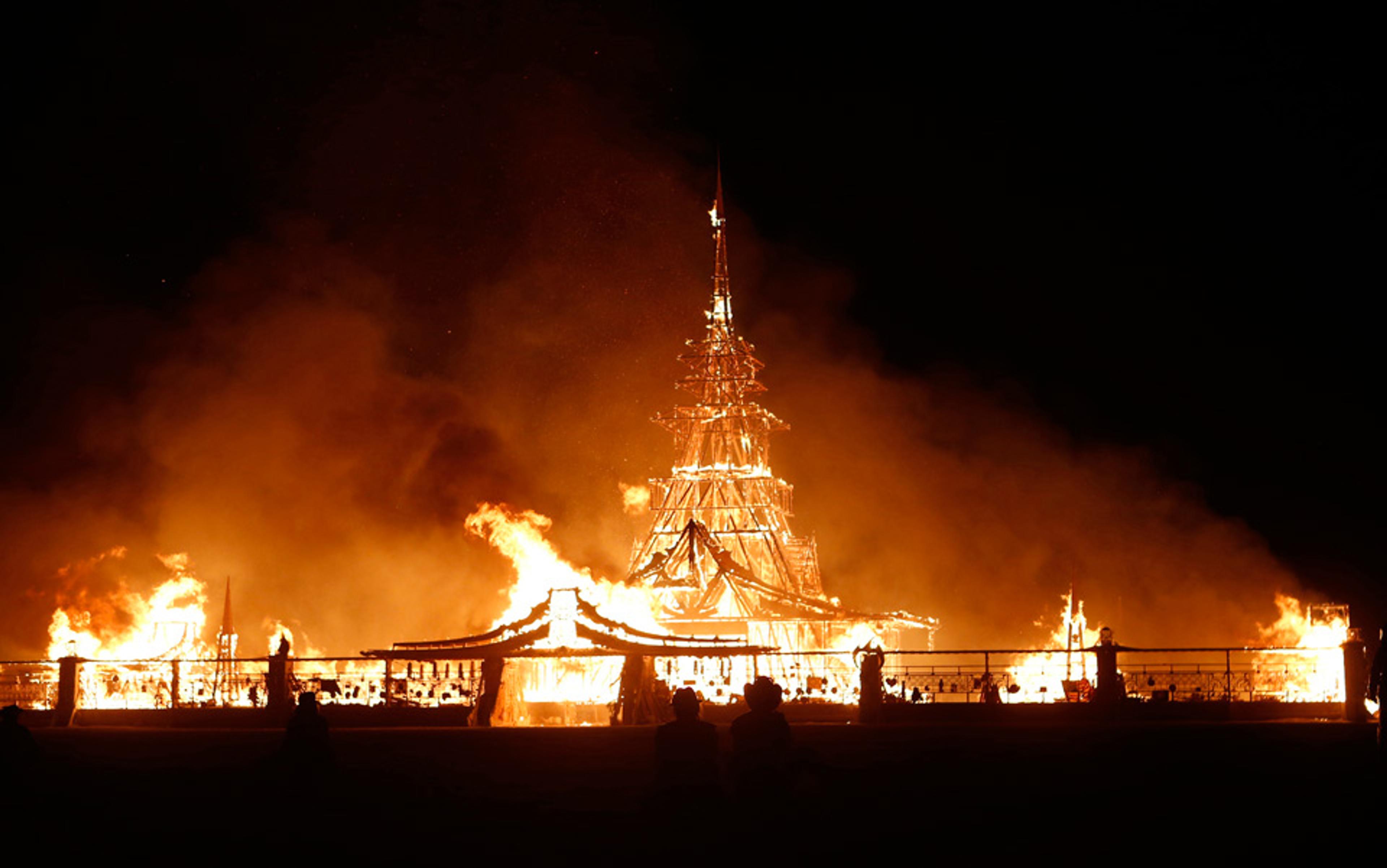
The Temple of Juno, with its messages and photos of the dead, burns while the crowd watches.
When tens of thousands of Burners gathered solemnly for the Temple Burn, someone flickered a laser pointer at its walls and a couple of other lasers joined in. They were immediately shouted down. An invisible boundary had been crossed: one person’s self-expression was another’s bad behavior, and the reverence that this final ritual required had been undermined. The lasers left, then one of them returned. The crowd started chanting in unison: ‘Turn your laser off.’ Soon, the fire was lit and the interruptions forgotten as flames roared and the air grew unbearably hot. Dust devils spun out from the fire as the spirits of the Temple carried messages to the dead and released mourners’ grief into the dark landscape all around. As the glowing embers of the Temple faded into dust and ashes, we returned to our camps, packed up our belongings and headed home. The desert had served its purpose and our mourning was done.
